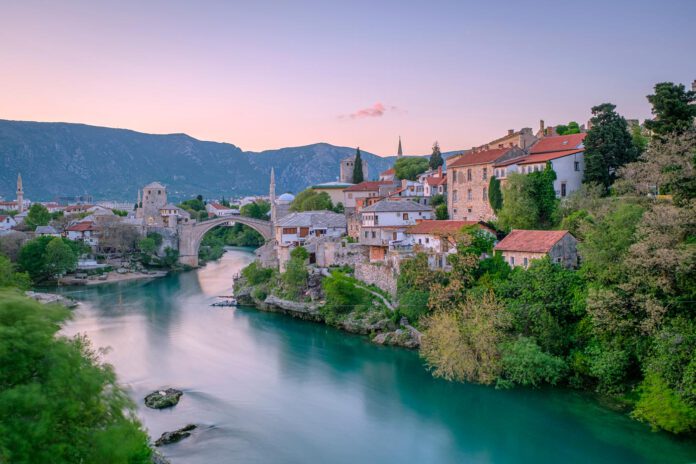A Long Weekend is Sufficient to be Enchanted by the Small Country in the Balkans. From the Ottoman Old Town of Sarajevo to the Moss-Green Mountain Landscape of the Dinaric Alps to the World-Famous Old Bridge in Mostar: Bosnia and Herzegovina’s Cultural and Landscape Diversity can be Easily Explored in a Few Days.
On the walls of the Yellow Bastion Žuta Tabija, high above the roofs of Sarajevo, dozens of onlookers have gathered. The scent of freshly baked bread wafts enticingly over the fortress. People have lugged drinks and food up the hill in large plastic bags. However, the Sarajlije, as the city’s inhabitants are called, are still exercising restraint. It is Ramadan, the Muslim fasting period, and eating and drinking are only allowed after sunset.
The signal for Iftar, the breaking of the fast, is impressively given by firing an old cannon. When the explosives expert, wearing the typical red felt hat, ignites the gunpowder charge, the bang can be heard throughout the city: the starting signal for the communal dinner. In the picturesque Ottoman Old Town, hungry families flock to restaurants and cafes and indulge in ĆevapÄići, small minced meat sausages, and Burek, a pastry filled with meat, cheese, or spinach.

During the festive season, the minarets of the mosques are particularly adorned, and the places of worship attract numerous people for Eid Fitr, the last day of Ramadan. At the five-hundred-year-old Gazi-Husrev-Beg Mosque, so many worshippers have gathered for the morning prayer that, dressed in their best suits, they must kneel in the courtyard in front of the building, even though it is pouring rain.

Signs of War
Just over half of the population of Bosnia and Herzegovina are Bosniaks of the Muslim faith; the rest are Serbian Orthodox or Catholic Christians. A melting pot of cultures, which is also reflected in the diverse architecture of the city. In addition to the Ottomans, the rulers of Austria-Hungary have also immortalized themselves with magnificent buildings. Because of this diversity, Sarajevo is sometimes referred to as the Jerusalem of the Balkans. However, the preserved bullet holes from the Bosnian War in the early 1990s still serve as a reminder that living together is not always easy.
Back then, the battles raged in large parts of the country. In Mostar, the Old Bridge, the landmark of the historic city, was almost completely destroyed, but since 2004, it has been restored to its former glory. A symbol of reconstruction. Even in the most remote shepherd villages of the Dinaric Alps, where there are more sheep than people, it is rare to find buildings older than thirty years. Hamdija, who could escape and returned to his mountainous homeland after the peace agreement, recounts how soldiers burned everything down at random during the war and razed entire villages to the ground.
His wife Hara does not like to remember those times and prefers to show off her traditional Bosnian festive attire and the warm wool socks she knits in winter to sell to traders from the capital. She prepares a strong Turkish-style coffee for guests; that’s what hospitality demands. Because even though the residential buildings are new, the well-known landmarks have been rebuilt, some of the old traditions endure.
Medieval Craftsmanship
This is also evident in the forests around Ocevija, an inconspicuous village north of Sarajevo. Little light penetrates the windowless wooden hut located by a small stream. The sooty interior walls bear witness to decades of burning fires, in whose flames the Jozeljic family men have been forging metal goods for generations. Since the Middle Ages, the methods have remained the same: without electricity, motors, or any other modern aids, Peka, Balkan pans, are crafted here.
